Report on Technology Implementation in Finance and Accounting
VerifiedAdded on 2023/06/11
|26
|6274
|61
Report
AI Summary
This report examines the implications of technology implementation within the finance and accounting departments of organizations in Australia. It highlights how automated software replaces traditional ledgers and accounting books, and how specialized auditing software enhances business activities. The research explores the impact of technology on accounting standards, focusing on how inadequate technology implementation can be a problem. It also discusses the benefits of technology, such as decreased lead times for financial information and improved reliability of accounting procedures. The report includes a literature review covering modern accounting systems, ethics, information technology, auditing, limitations of technology, and managerial implications. The research methodology involves analyzing data from 20 public listed companies in Australia, using surveys and statistical tools to assess the effectiveness of accounting technology.
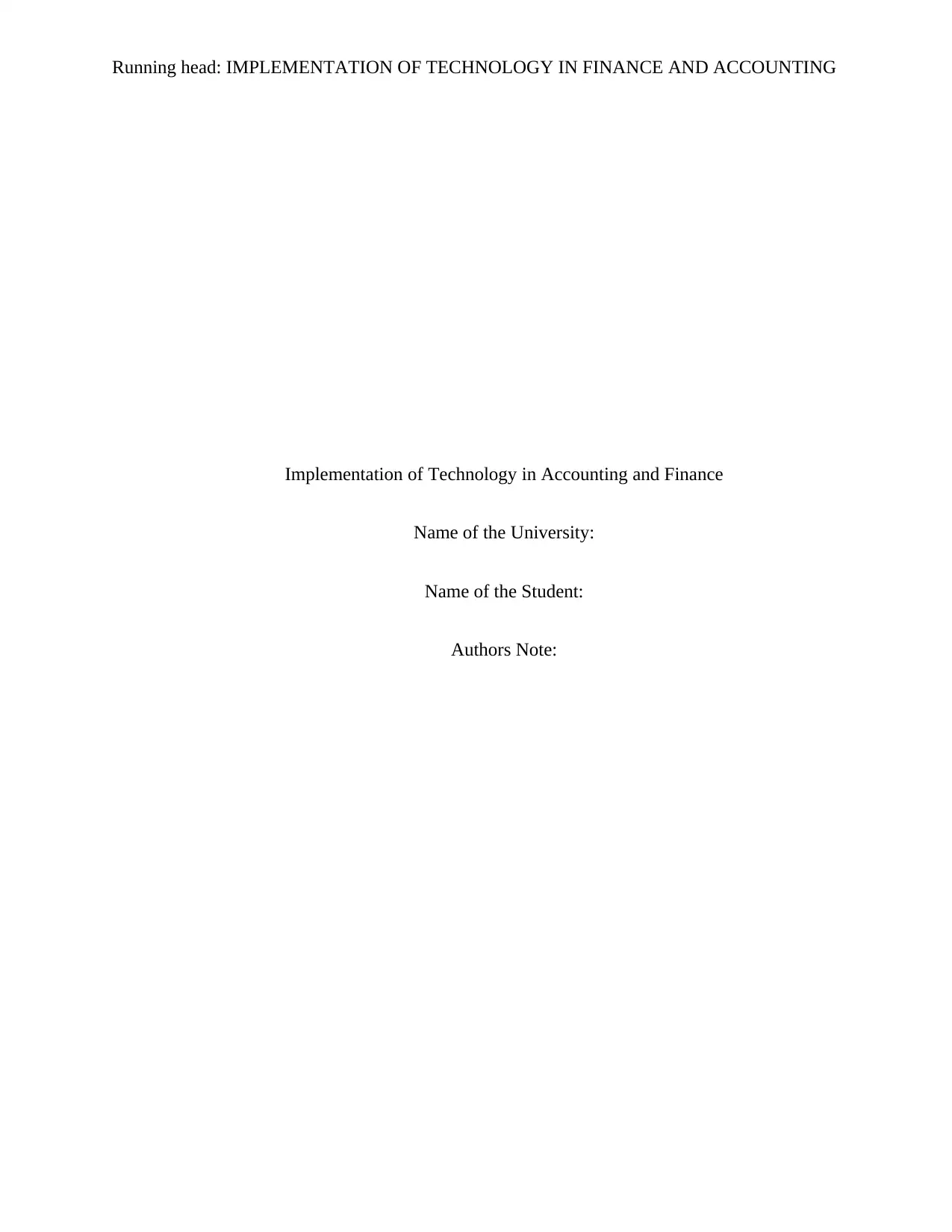
Running head: IMPLEMENTATION OF TECHNOLOGY IN FINANCE AND ACCOUNTING
Implementation of Technology in Accounting and Finance
Name of the University:
Name of the Student:
Authors Note:
Implementation of Technology in Accounting and Finance
Name of the University:
Name of the Student:
Authors Note:
Paraphrase This Document
Need a fresh take? Get an instant paraphrase of this document with our AI Paraphraser
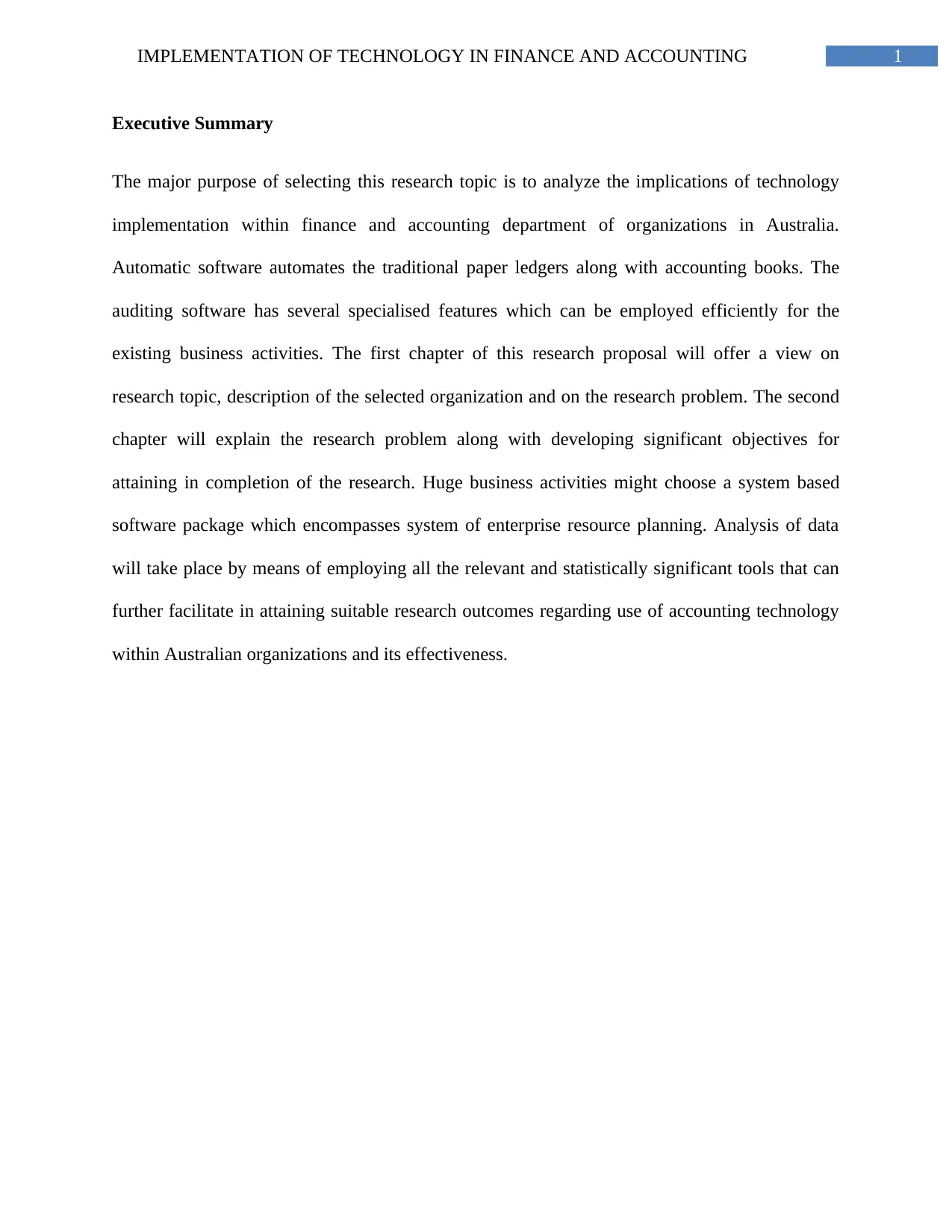
1IMPLEMENTATION OF TECHNOLOGY IN FINANCE AND ACCOUNTING
Executive Summary
The major purpose of selecting this research topic is to analyze the implications of technology
implementation within finance and accounting department of organizations in Australia.
Automatic software automates the traditional paper ledgers along with accounting books. The
auditing software has several specialised features which can be employed efficiently for the
existing business activities. The first chapter of this research proposal will offer a view on
research topic, description of the selected organization and on the research problem. The second
chapter will explain the research problem along with developing significant objectives for
attaining in completion of the research. Huge business activities might choose a system based
software package which encompasses system of enterprise resource planning. Analysis of data
will take place by means of employing all the relevant and statistically significant tools that can
further facilitate in attaining suitable research outcomes regarding use of accounting technology
within Australian organizations and its effectiveness.
Executive Summary
The major purpose of selecting this research topic is to analyze the implications of technology
implementation within finance and accounting department of organizations in Australia.
Automatic software automates the traditional paper ledgers along with accounting books. The
auditing software has several specialised features which can be employed efficiently for the
existing business activities. The first chapter of this research proposal will offer a view on
research topic, description of the selected organization and on the research problem. The second
chapter will explain the research problem along with developing significant objectives for
attaining in completion of the research. Huge business activities might choose a system based
software package which encompasses system of enterprise resource planning. Analysis of data
will take place by means of employing all the relevant and statistically significant tools that can
further facilitate in attaining suitable research outcomes regarding use of accounting technology
within Australian organizations and its effectiveness.
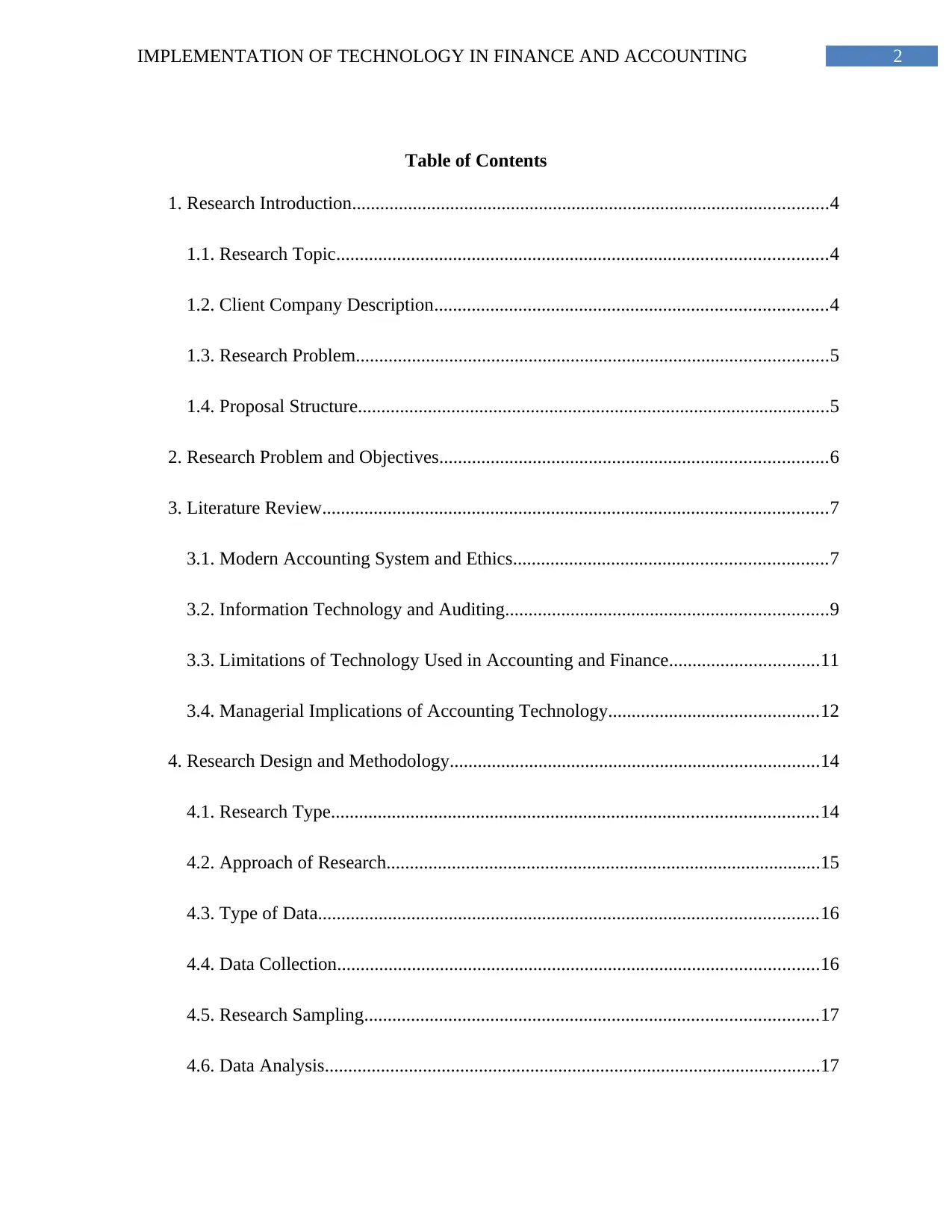
2IMPLEMENTATION OF TECHNOLOGY IN FINANCE AND ACCOUNTING
Table of Contents
1. Research Introduction......................................................................................................4
1.1. Research Topic.........................................................................................................4
1.2. Client Company Description....................................................................................4
1.3. Research Problem.....................................................................................................5
1.4. Proposal Structure.....................................................................................................5
2. Research Problem and Objectives...................................................................................6
3. Literature Review............................................................................................................7
3.1. Modern Accounting System and Ethics...................................................................7
3.2. Information Technology and Auditing.....................................................................9
3.3. Limitations of Technology Used in Accounting and Finance................................11
3.4. Managerial Implications of Accounting Technology.............................................12
4. Research Design and Methodology...............................................................................14
4.1. Research Type........................................................................................................14
4.2. Approach of Research.............................................................................................15
4.3. Type of Data...........................................................................................................16
4.4. Data Collection.......................................................................................................16
4.5. Research Sampling.................................................................................................17
4.6. Data Analysis..........................................................................................................17
Table of Contents
1. Research Introduction......................................................................................................4
1.1. Research Topic.........................................................................................................4
1.2. Client Company Description....................................................................................4
1.3. Research Problem.....................................................................................................5
1.4. Proposal Structure.....................................................................................................5
2. Research Problem and Objectives...................................................................................6
3. Literature Review............................................................................................................7
3.1. Modern Accounting System and Ethics...................................................................7
3.2. Information Technology and Auditing.....................................................................9
3.3. Limitations of Technology Used in Accounting and Finance................................11
3.4. Managerial Implications of Accounting Technology.............................................12
4. Research Design and Methodology...............................................................................14
4.1. Research Type........................................................................................................14
4.2. Approach of Research.............................................................................................15
4.3. Type of Data...........................................................................................................16
4.4. Data Collection.......................................................................................................16
4.5. Research Sampling.................................................................................................17
4.6. Data Analysis..........................................................................................................17
⊘ This is a preview!⊘
Do you want full access?
Subscribe today to unlock all pages.

Trusted by 1+ million students worldwide
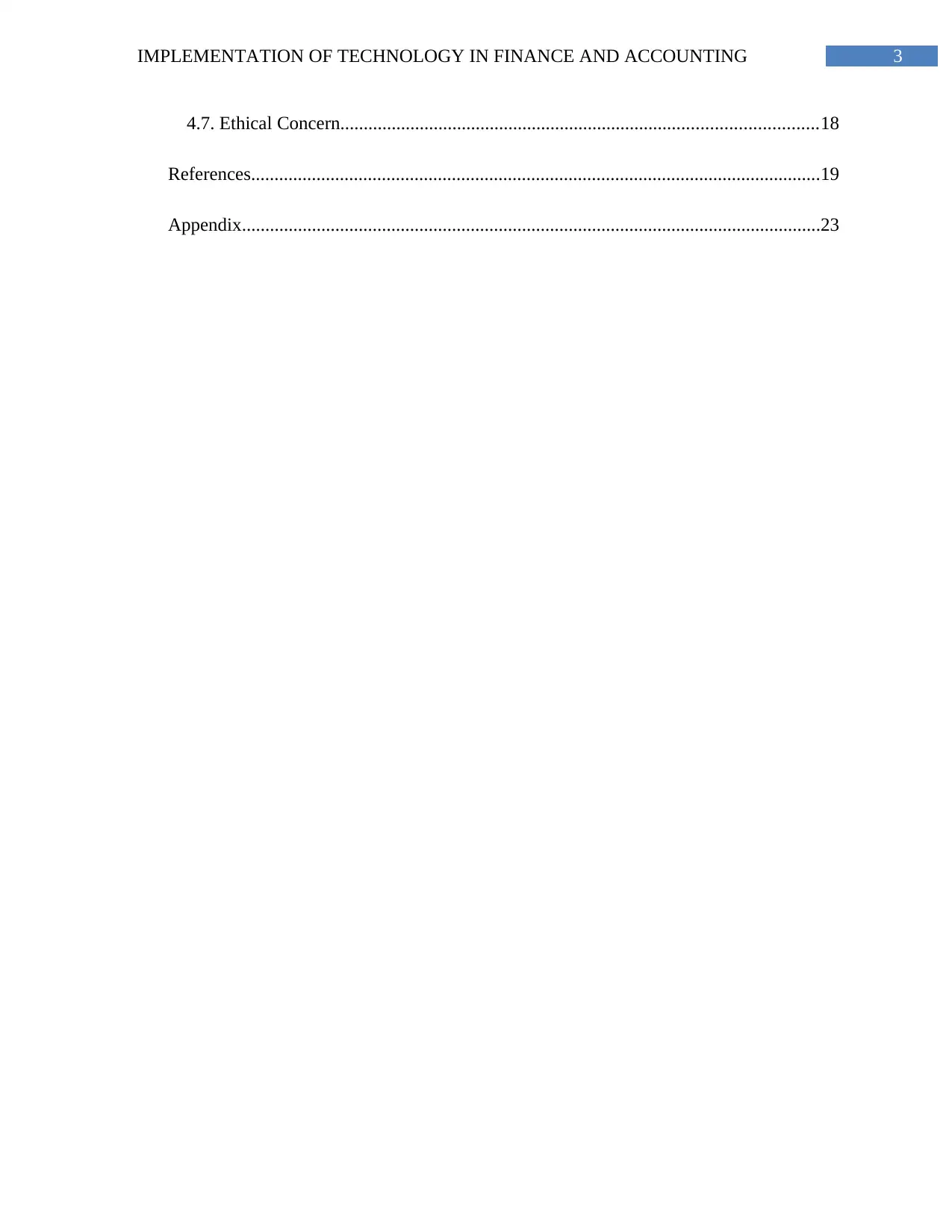
3IMPLEMENTATION OF TECHNOLOGY IN FINANCE AND ACCOUNTING
4.7. Ethical Concern......................................................................................................18
References..........................................................................................................................19
Appendix............................................................................................................................23
4.7. Ethical Concern......................................................................................................18
References..........................................................................................................................19
Appendix............................................................................................................................23
Paraphrase This Document
Need a fresh take? Get an instant paraphrase of this document with our AI Paraphraser
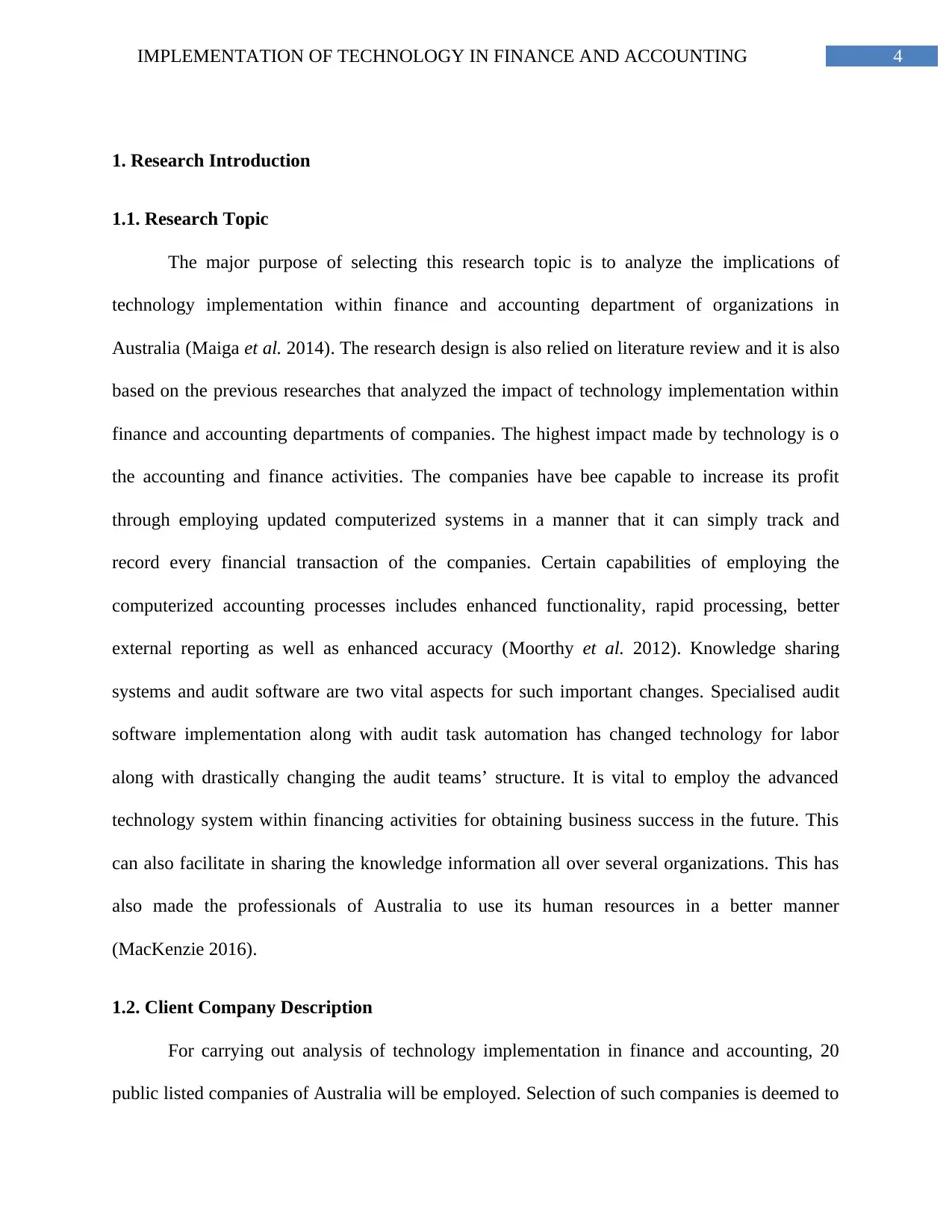
4IMPLEMENTATION OF TECHNOLOGY IN FINANCE AND ACCOUNTING
1. Research Introduction
1.1. Research Topic
The major purpose of selecting this research topic is to analyze the implications of
technology implementation within finance and accounting department of organizations in
Australia (Maiga et al. 2014). The research design is also relied on literature review and it is also
based on the previous researches that analyzed the impact of technology implementation within
finance and accounting departments of companies. The highest impact made by technology is o
the accounting and finance activities. The companies have bee capable to increase its profit
through employing updated computerized systems in a manner that it can simply track and
record every financial transaction of the companies. Certain capabilities of employing the
computerized accounting processes includes enhanced functionality, rapid processing, better
external reporting as well as enhanced accuracy (Moorthy et al. 2012). Knowledge sharing
systems and audit software are two vital aspects for such important changes. Specialised audit
software implementation along with audit task automation has changed technology for labor
along with drastically changing the audit teams’ structure. It is vital to employ the advanced
technology system within financing activities for obtaining business success in the future. This
can also facilitate in sharing the knowledge information all over several organizations. This has
also made the professionals of Australia to use its human resources in a better manner
(MacKenzie 2016).
1.2. Client Company Description
For carrying out analysis of technology implementation in finance and accounting, 20
public listed companies of Australia will be employed. Selection of such companies is deemed to
1. Research Introduction
1.1. Research Topic
The major purpose of selecting this research topic is to analyze the implications of
technology implementation within finance and accounting department of organizations in
Australia (Maiga et al. 2014). The research design is also relied on literature review and it is also
based on the previous researches that analyzed the impact of technology implementation within
finance and accounting departments of companies. The highest impact made by technology is o
the accounting and finance activities. The companies have bee capable to increase its profit
through employing updated computerized systems in a manner that it can simply track and
record every financial transaction of the companies. Certain capabilities of employing the
computerized accounting processes includes enhanced functionality, rapid processing, better
external reporting as well as enhanced accuracy (Moorthy et al. 2012). Knowledge sharing
systems and audit software are two vital aspects for such important changes. Specialised audit
software implementation along with audit task automation has changed technology for labor
along with drastically changing the audit teams’ structure. It is vital to employ the advanced
technology system within financing activities for obtaining business success in the future. This
can also facilitate in sharing the knowledge information all over several organizations. This has
also made the professionals of Australia to use its human resources in a better manner
(MacKenzie 2016).
1.2. Client Company Description
For carrying out analysis of technology implementation in finance and accounting, 20
public listed companies of Australia will be employed. Selection of such companies is deemed to
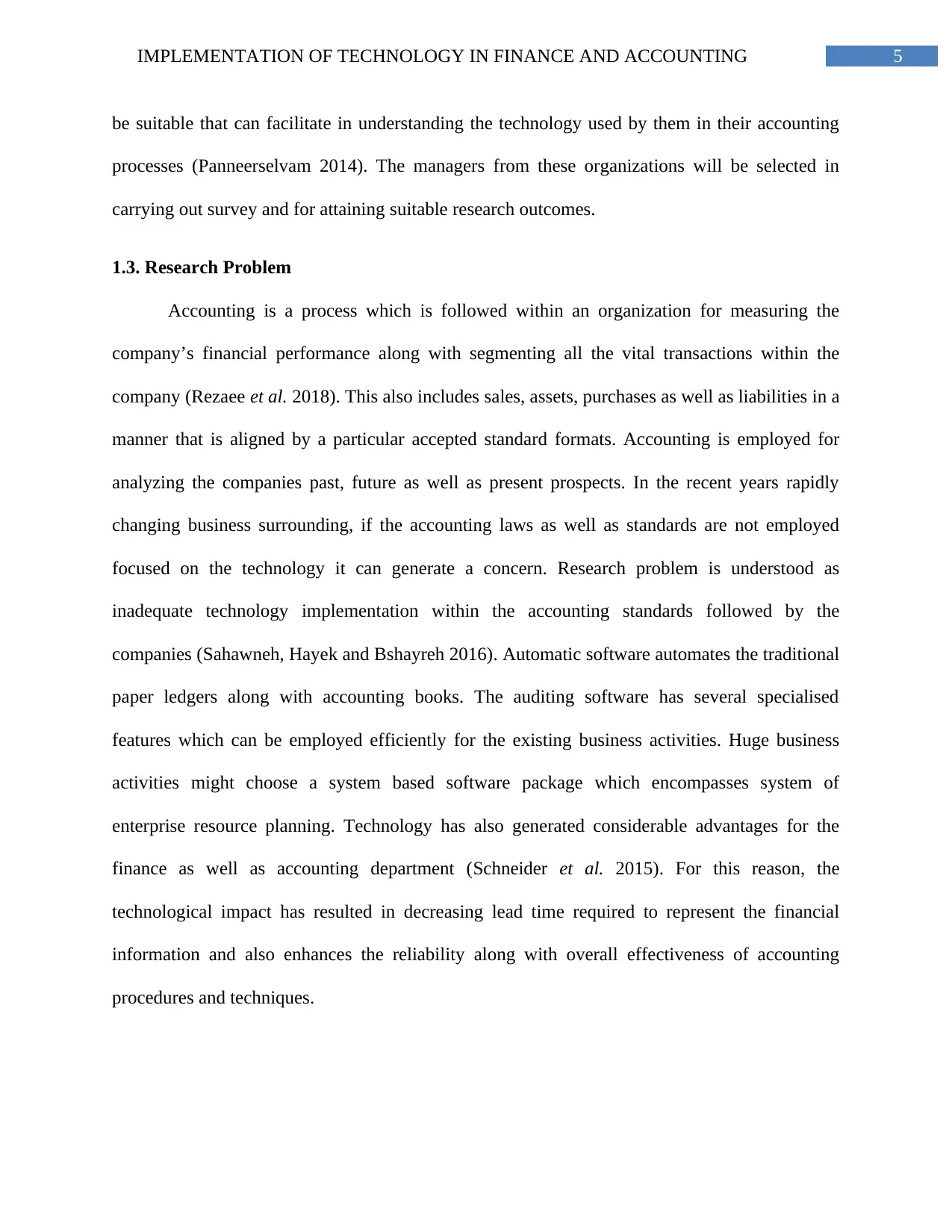
5IMPLEMENTATION OF TECHNOLOGY IN FINANCE AND ACCOUNTING
be suitable that can facilitate in understanding the technology used by them in their accounting
processes (Panneerselvam 2014). The managers from these organizations will be selected in
carrying out survey and for attaining suitable research outcomes.
1.3. Research Problem
Accounting is a process which is followed within an organization for measuring the
company’s financial performance along with segmenting all the vital transactions within the
company (Rezaee et al. 2018). This also includes sales, assets, purchases as well as liabilities in a
manner that is aligned by a particular accepted standard formats. Accounting is employed for
analyzing the companies past, future as well as present prospects. In the recent years rapidly
changing business surrounding, if the accounting laws as well as standards are not employed
focused on the technology it can generate a concern. Research problem is understood as
inadequate technology implementation within the accounting standards followed by the
companies (Sahawneh, Hayek and Bshayreh 2016). Automatic software automates the traditional
paper ledgers along with accounting books. The auditing software has several specialised
features which can be employed efficiently for the existing business activities. Huge business
activities might choose a system based software package which encompasses system of
enterprise resource planning. Technology has also generated considerable advantages for the
finance as well as accounting department (Schneider et al. 2015). For this reason, the
technological impact has resulted in decreasing lead time required to represent the financial
information and also enhances the reliability along with overall effectiveness of accounting
procedures and techniques.
be suitable that can facilitate in understanding the technology used by them in their accounting
processes (Panneerselvam 2014). The managers from these organizations will be selected in
carrying out survey and for attaining suitable research outcomes.
1.3. Research Problem
Accounting is a process which is followed within an organization for measuring the
company’s financial performance along with segmenting all the vital transactions within the
company (Rezaee et al. 2018). This also includes sales, assets, purchases as well as liabilities in a
manner that is aligned by a particular accepted standard formats. Accounting is employed for
analyzing the companies past, future as well as present prospects. In the recent years rapidly
changing business surrounding, if the accounting laws as well as standards are not employed
focused on the technology it can generate a concern. Research problem is understood as
inadequate technology implementation within the accounting standards followed by the
companies (Sahawneh, Hayek and Bshayreh 2016). Automatic software automates the traditional
paper ledgers along with accounting books. The auditing software has several specialised
features which can be employed efficiently for the existing business activities. Huge business
activities might choose a system based software package which encompasses system of
enterprise resource planning. Technology has also generated considerable advantages for the
finance as well as accounting department (Schneider et al. 2015). For this reason, the
technological impact has resulted in decreasing lead time required to represent the financial
information and also enhances the reliability along with overall effectiveness of accounting
procedures and techniques.
⊘ This is a preview!⊘
Do you want full access?
Subscribe today to unlock all pages.

Trusted by 1+ million students worldwide
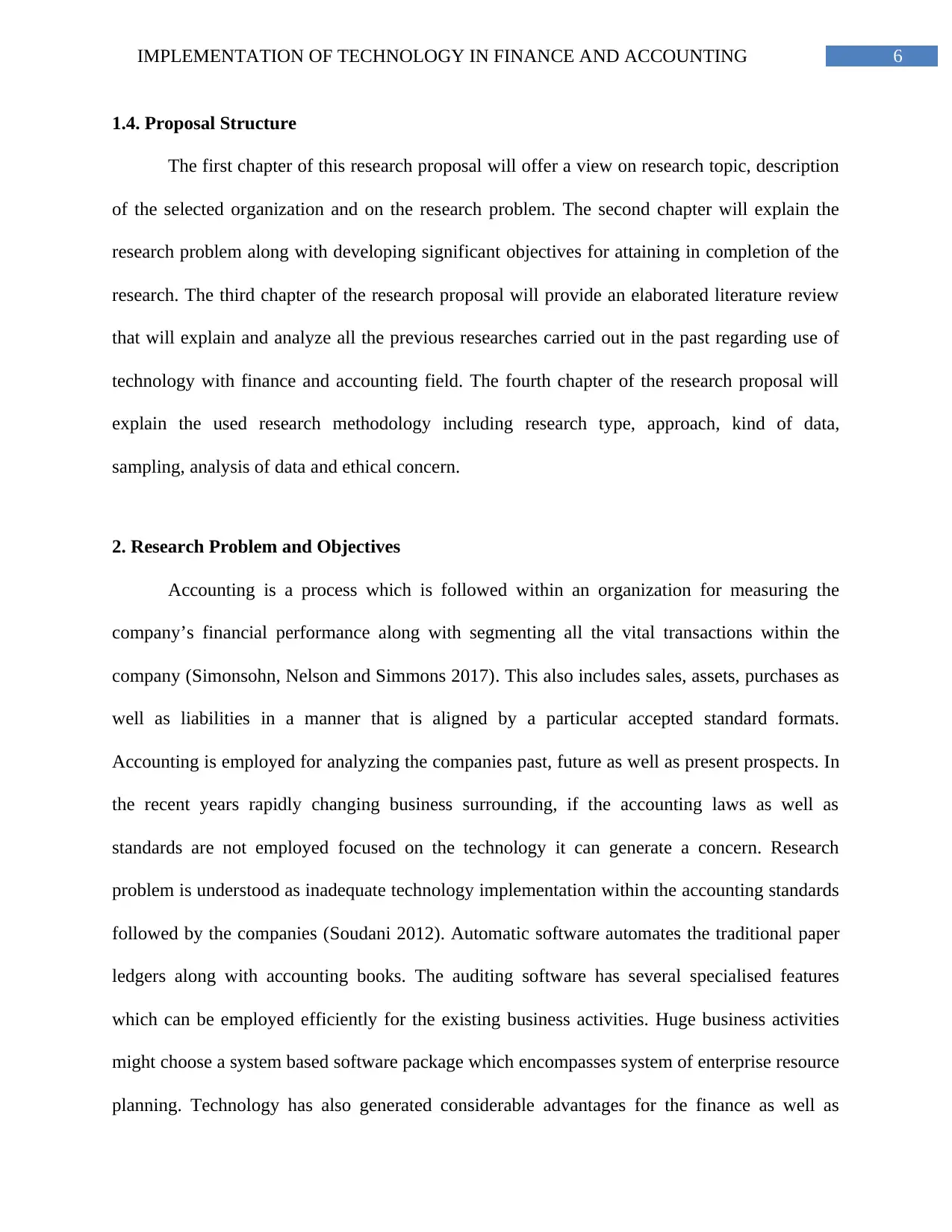
6IMPLEMENTATION OF TECHNOLOGY IN FINANCE AND ACCOUNTING
1.4. Proposal Structure
The first chapter of this research proposal will offer a view on research topic, description
of the selected organization and on the research problem. The second chapter will explain the
research problem along with developing significant objectives for attaining in completion of the
research. The third chapter of the research proposal will provide an elaborated literature review
that will explain and analyze all the previous researches carried out in the past regarding use of
technology with finance and accounting field. The fourth chapter of the research proposal will
explain the used research methodology including research type, approach, kind of data,
sampling, analysis of data and ethical concern.
2. Research Problem and Objectives
Accounting is a process which is followed within an organization for measuring the
company’s financial performance along with segmenting all the vital transactions within the
company (Simonsohn, Nelson and Simmons 2017). This also includes sales, assets, purchases as
well as liabilities in a manner that is aligned by a particular accepted standard formats.
Accounting is employed for analyzing the companies past, future as well as present prospects. In
the recent years rapidly changing business surrounding, if the accounting laws as well as
standards are not employed focused on the technology it can generate a concern. Research
problem is understood as inadequate technology implementation within the accounting standards
followed by the companies (Soudani 2012). Automatic software automates the traditional paper
ledgers along with accounting books. The auditing software has several specialised features
which can be employed efficiently for the existing business activities. Huge business activities
might choose a system based software package which encompasses system of enterprise resource
planning. Technology has also generated considerable advantages for the finance as well as
1.4. Proposal Structure
The first chapter of this research proposal will offer a view on research topic, description
of the selected organization and on the research problem. The second chapter will explain the
research problem along with developing significant objectives for attaining in completion of the
research. The third chapter of the research proposal will provide an elaborated literature review
that will explain and analyze all the previous researches carried out in the past regarding use of
technology with finance and accounting field. The fourth chapter of the research proposal will
explain the used research methodology including research type, approach, kind of data,
sampling, analysis of data and ethical concern.
2. Research Problem and Objectives
Accounting is a process which is followed within an organization for measuring the
company’s financial performance along with segmenting all the vital transactions within the
company (Simonsohn, Nelson and Simmons 2017). This also includes sales, assets, purchases as
well as liabilities in a manner that is aligned by a particular accepted standard formats.
Accounting is employed for analyzing the companies past, future as well as present prospects. In
the recent years rapidly changing business surrounding, if the accounting laws as well as
standards are not employed focused on the technology it can generate a concern. Research
problem is understood as inadequate technology implementation within the accounting standards
followed by the companies (Soudani 2012). Automatic software automates the traditional paper
ledgers along with accounting books. The auditing software has several specialised features
which can be employed efficiently for the existing business activities. Huge business activities
might choose a system based software package which encompasses system of enterprise resource
planning. Technology has also generated considerable advantages for the finance as well as
Paraphrase This Document
Need a fresh take? Get an instant paraphrase of this document with our AI Paraphraser
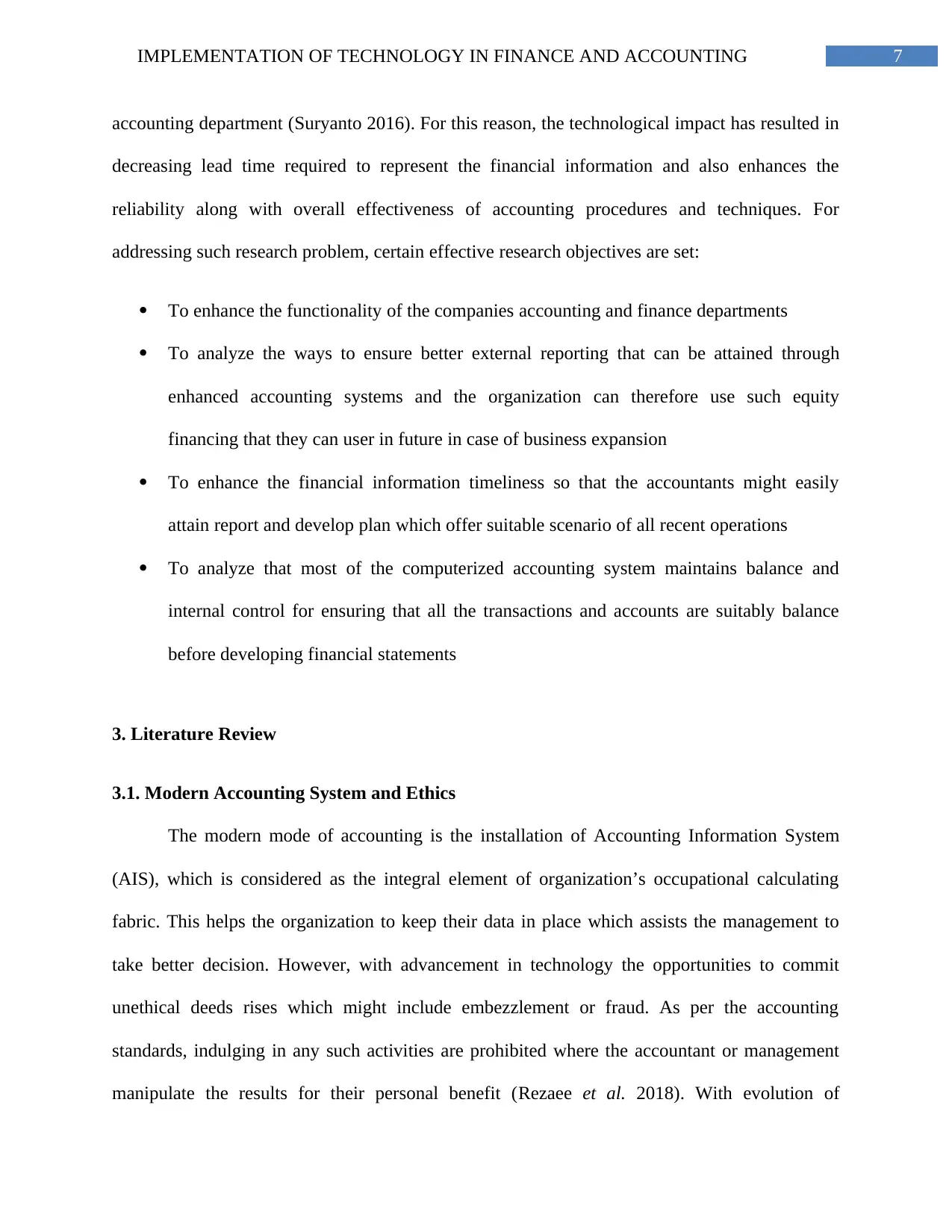
7IMPLEMENTATION OF TECHNOLOGY IN FINANCE AND ACCOUNTING
accounting department (Suryanto 2016). For this reason, the technological impact has resulted in
decreasing lead time required to represent the financial information and also enhances the
reliability along with overall effectiveness of accounting procedures and techniques. For
addressing such research problem, certain effective research objectives are set:
To enhance the functionality of the companies accounting and finance departments
To analyze the ways to ensure better external reporting that can be attained through
enhanced accounting systems and the organization can therefore use such equity
financing that they can user in future in case of business expansion
To enhance the financial information timeliness so that the accountants might easily
attain report and develop plan which offer suitable scenario of all recent operations
To analyze that most of the computerized accounting system maintains balance and
internal control for ensuring that all the transactions and accounts are suitably balance
before developing financial statements
3. Literature Review
3.1. Modern Accounting System and Ethics
The modern mode of accounting is the installation of Accounting Information System
(AIS), which is considered as the integral element of organization’s occupational calculating
fabric. This helps the organization to keep their data in place which assists the management to
take better decision. However, with advancement in technology the opportunities to commit
unethical deeds rises which might include embezzlement or fraud. As per the accounting
standards, indulging in any such activities are prohibited where the accountant or management
manipulate the results for their personal benefit (Rezaee et al. 2018). With evolution of
accounting department (Suryanto 2016). For this reason, the technological impact has resulted in
decreasing lead time required to represent the financial information and also enhances the
reliability along with overall effectiveness of accounting procedures and techniques. For
addressing such research problem, certain effective research objectives are set:
To enhance the functionality of the companies accounting and finance departments
To analyze the ways to ensure better external reporting that can be attained through
enhanced accounting systems and the organization can therefore use such equity
financing that they can user in future in case of business expansion
To enhance the financial information timeliness so that the accountants might easily
attain report and develop plan which offer suitable scenario of all recent operations
To analyze that most of the computerized accounting system maintains balance and
internal control for ensuring that all the transactions and accounts are suitably balance
before developing financial statements
3. Literature Review
3.1. Modern Accounting System and Ethics
The modern mode of accounting is the installation of Accounting Information System
(AIS), which is considered as the integral element of organization’s occupational calculating
fabric. This helps the organization to keep their data in place which assists the management to
take better decision. However, with advancement in technology the opportunities to commit
unethical deeds rises which might include embezzlement or fraud. As per the accounting
standards, indulging in any such activities are prohibited where the accountant or management
manipulate the results for their personal benefit (Rezaee et al. 2018). With evolution of
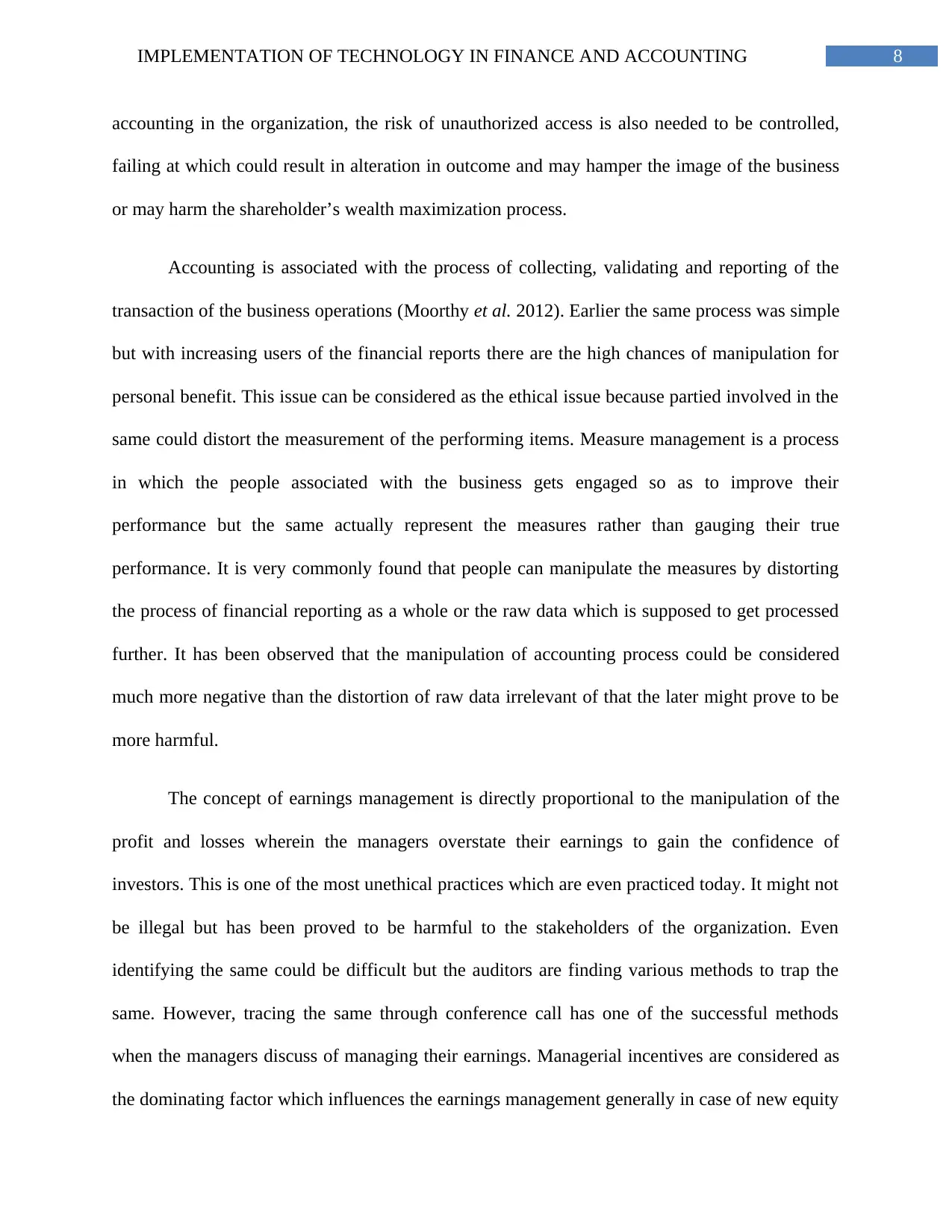
8IMPLEMENTATION OF TECHNOLOGY IN FINANCE AND ACCOUNTING
accounting in the organization, the risk of unauthorized access is also needed to be controlled,
failing at which could result in alteration in outcome and may hamper the image of the business
or may harm the shareholder’s wealth maximization process.
Accounting is associated with the process of collecting, validating and reporting of the
transaction of the business operations (Moorthy et al. 2012). Earlier the same process was simple
but with increasing users of the financial reports there are the high chances of manipulation for
personal benefit. This issue can be considered as the ethical issue because partied involved in the
same could distort the measurement of the performing items. Measure management is a process
in which the people associated with the business gets engaged so as to improve their
performance but the same actually represent the measures rather than gauging their true
performance. It is very commonly found that people can manipulate the measures by distorting
the process of financial reporting as a whole or the raw data which is supposed to get processed
further. It has been observed that the manipulation of accounting process could be considered
much more negative than the distortion of raw data irrelevant of that the later might prove to be
more harmful.
The concept of earnings management is directly proportional to the manipulation of the
profit and losses wherein the managers overstate their earnings to gain the confidence of
investors. This is one of the most unethical practices which are even practiced today. It might not
be illegal but has been proved to be harmful to the stakeholders of the organization. Even
identifying the same could be difficult but the auditors are finding various methods to trap the
same. However, tracing the same through conference call has one of the successful methods
when the managers discuss of managing their earnings. Managerial incentives are considered as
the dominating factor which influences the earnings management generally in case of new equity
accounting in the organization, the risk of unauthorized access is also needed to be controlled,
failing at which could result in alteration in outcome and may hamper the image of the business
or may harm the shareholder’s wealth maximization process.
Accounting is associated with the process of collecting, validating and reporting of the
transaction of the business operations (Moorthy et al. 2012). Earlier the same process was simple
but with increasing users of the financial reports there are the high chances of manipulation for
personal benefit. This issue can be considered as the ethical issue because partied involved in the
same could distort the measurement of the performing items. Measure management is a process
in which the people associated with the business gets engaged so as to improve their
performance but the same actually represent the measures rather than gauging their true
performance. It is very commonly found that people can manipulate the measures by distorting
the process of financial reporting as a whole or the raw data which is supposed to get processed
further. It has been observed that the manipulation of accounting process could be considered
much more negative than the distortion of raw data irrelevant of that the later might prove to be
more harmful.
The concept of earnings management is directly proportional to the manipulation of the
profit and losses wherein the managers overstate their earnings to gain the confidence of
investors. This is one of the most unethical practices which are even practiced today. It might not
be illegal but has been proved to be harmful to the stakeholders of the organization. Even
identifying the same could be difficult but the auditors are finding various methods to trap the
same. However, tracing the same through conference call has one of the successful methods
when the managers discuss of managing their earnings. Managerial incentives are considered as
the dominating factor which influences the earnings management generally in case of new equity
⊘ This is a preview!⊘
Do you want full access?
Subscribe today to unlock all pages.

Trusted by 1+ million students worldwide
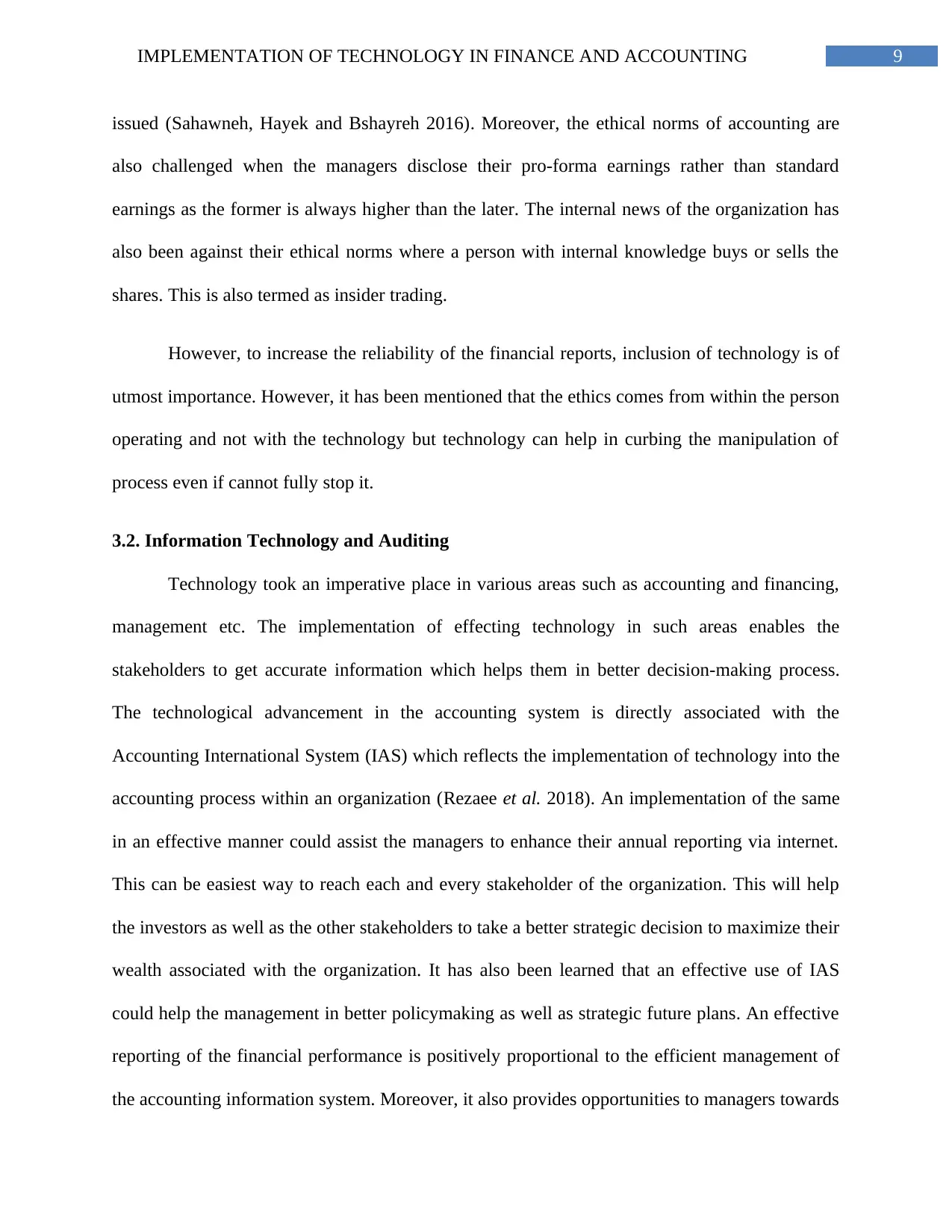
9IMPLEMENTATION OF TECHNOLOGY IN FINANCE AND ACCOUNTING
issued (Sahawneh, Hayek and Bshayreh 2016). Moreover, the ethical norms of accounting are
also challenged when the managers disclose their pro-forma earnings rather than standard
earnings as the former is always higher than the later. The internal news of the organization has
also been against their ethical norms where a person with internal knowledge buys or sells the
shares. This is also termed as insider trading.
However, to increase the reliability of the financial reports, inclusion of technology is of
utmost importance. However, it has been mentioned that the ethics comes from within the person
operating and not with the technology but technology can help in curbing the manipulation of
process even if cannot fully stop it.
3.2. Information Technology and Auditing
Technology took an imperative place in various areas such as accounting and financing,
management etc. The implementation of effecting technology in such areas enables the
stakeholders to get accurate information which helps them in better decision-making process.
The technological advancement in the accounting system is directly associated with the
Accounting International System (IAS) which reflects the implementation of technology into the
accounting process within an organization (Rezaee et al. 2018). An implementation of the same
in an effective manner could assist the managers to enhance their annual reporting via internet.
This can be easiest way to reach each and every stakeholder of the organization. This will help
the investors as well as the other stakeholders to take a better strategic decision to maximize their
wealth associated with the organization. It has also been learned that an effective use of IAS
could help the management in better policymaking as well as strategic future plans. An effective
reporting of the financial performance is positively proportional to the efficient management of
the accounting information system. Moreover, it also provides opportunities to managers towards
issued (Sahawneh, Hayek and Bshayreh 2016). Moreover, the ethical norms of accounting are
also challenged when the managers disclose their pro-forma earnings rather than standard
earnings as the former is always higher than the later. The internal news of the organization has
also been against their ethical norms where a person with internal knowledge buys or sells the
shares. This is also termed as insider trading.
However, to increase the reliability of the financial reports, inclusion of technology is of
utmost importance. However, it has been mentioned that the ethics comes from within the person
operating and not with the technology but technology can help in curbing the manipulation of
process even if cannot fully stop it.
3.2. Information Technology and Auditing
Technology took an imperative place in various areas such as accounting and financing,
management etc. The implementation of effecting technology in such areas enables the
stakeholders to get accurate information which helps them in better decision-making process.
The technological advancement in the accounting system is directly associated with the
Accounting International System (IAS) which reflects the implementation of technology into the
accounting process within an organization (Rezaee et al. 2018). An implementation of the same
in an effective manner could assist the managers to enhance their annual reporting via internet.
This can be easiest way to reach each and every stakeholder of the organization. This will help
the investors as well as the other stakeholders to take a better strategic decision to maximize their
wealth associated with the organization. It has also been learned that an effective use of IAS
could help the management in better policymaking as well as strategic future plans. An effective
reporting of the financial performance is positively proportional to the efficient management of
the accounting information system. Moreover, it also provides opportunities to managers towards
Paraphrase This Document
Need a fresh take? Get an instant paraphrase of this document with our AI Paraphraser
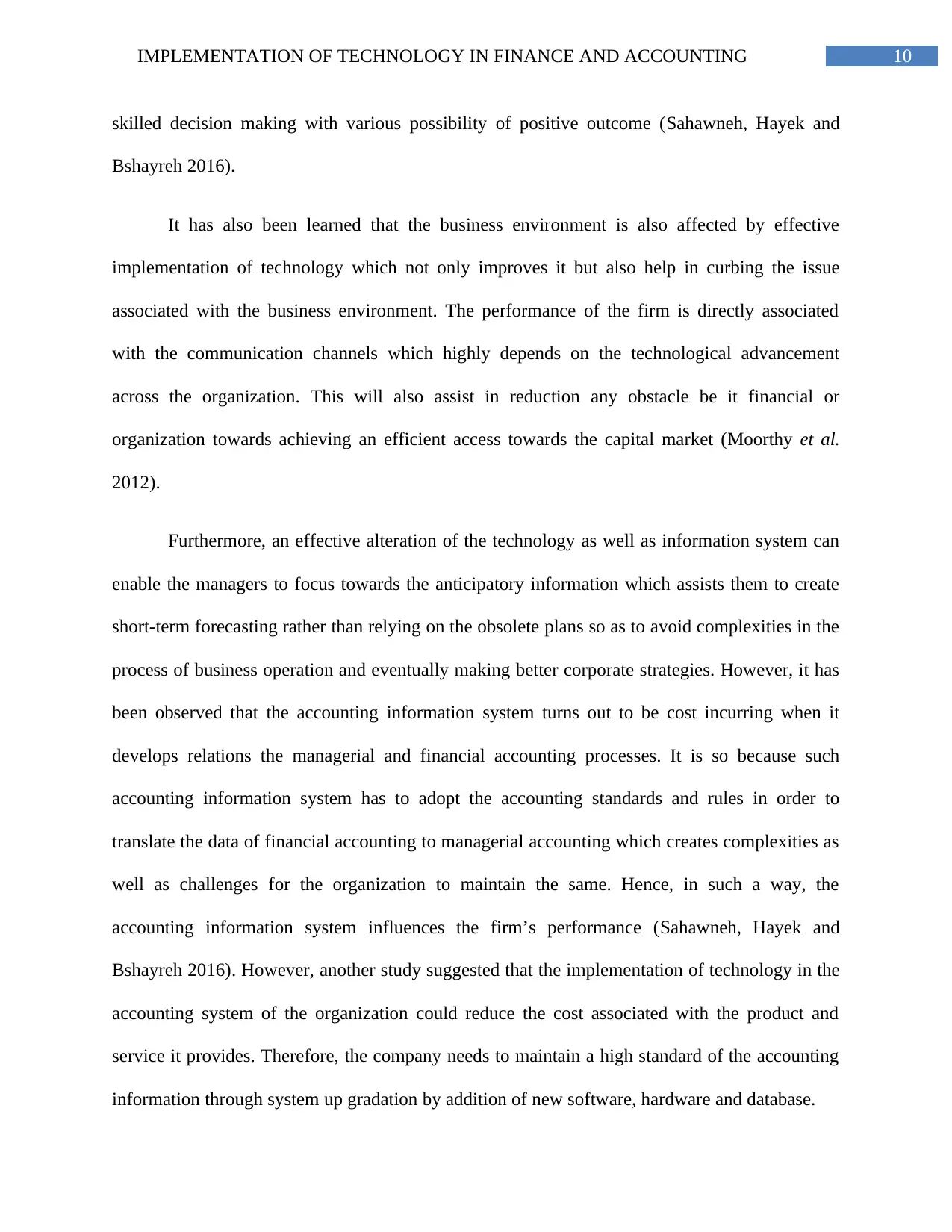
10IMPLEMENTATION OF TECHNOLOGY IN FINANCE AND ACCOUNTING
skilled decision making with various possibility of positive outcome (Sahawneh, Hayek and
Bshayreh 2016).
It has also been learned that the business environment is also affected by effective
implementation of technology which not only improves it but also help in curbing the issue
associated with the business environment. The performance of the firm is directly associated
with the communication channels which highly depends on the technological advancement
across the organization. This will also assist in reduction any obstacle be it financial or
organization towards achieving an efficient access towards the capital market (Moorthy et al.
2012).
Furthermore, an effective alteration of the technology as well as information system can
enable the managers to focus towards the anticipatory information which assists them to create
short-term forecasting rather than relying on the obsolete plans so as to avoid complexities in the
process of business operation and eventually making better corporate strategies. However, it has
been observed that the accounting information system turns out to be cost incurring when it
develops relations the managerial and financial accounting processes. It is so because such
accounting information system has to adopt the accounting standards and rules in order to
translate the data of financial accounting to managerial accounting which creates complexities as
well as challenges for the organization to maintain the same. Hence, in such a way, the
accounting information system influences the firm’s performance (Sahawneh, Hayek and
Bshayreh 2016). However, another study suggested that the implementation of technology in the
accounting system of the organization could reduce the cost associated with the product and
service it provides. Therefore, the company needs to maintain a high standard of the accounting
information through system up gradation by addition of new software, hardware and database.
skilled decision making with various possibility of positive outcome (Sahawneh, Hayek and
Bshayreh 2016).
It has also been learned that the business environment is also affected by effective
implementation of technology which not only improves it but also help in curbing the issue
associated with the business environment. The performance of the firm is directly associated
with the communication channels which highly depends on the technological advancement
across the organization. This will also assist in reduction any obstacle be it financial or
organization towards achieving an efficient access towards the capital market (Moorthy et al.
2012).
Furthermore, an effective alteration of the technology as well as information system can
enable the managers to focus towards the anticipatory information which assists them to create
short-term forecasting rather than relying on the obsolete plans so as to avoid complexities in the
process of business operation and eventually making better corporate strategies. However, it has
been observed that the accounting information system turns out to be cost incurring when it
develops relations the managerial and financial accounting processes. It is so because such
accounting information system has to adopt the accounting standards and rules in order to
translate the data of financial accounting to managerial accounting which creates complexities as
well as challenges for the organization to maintain the same. Hence, in such a way, the
accounting information system influences the firm’s performance (Sahawneh, Hayek and
Bshayreh 2016). However, another study suggested that the implementation of technology in the
accounting system of the organization could reduce the cost associated with the product and
service it provides. Therefore, the company needs to maintain a high standard of the accounting
information through system up gradation by addition of new software, hardware and database.
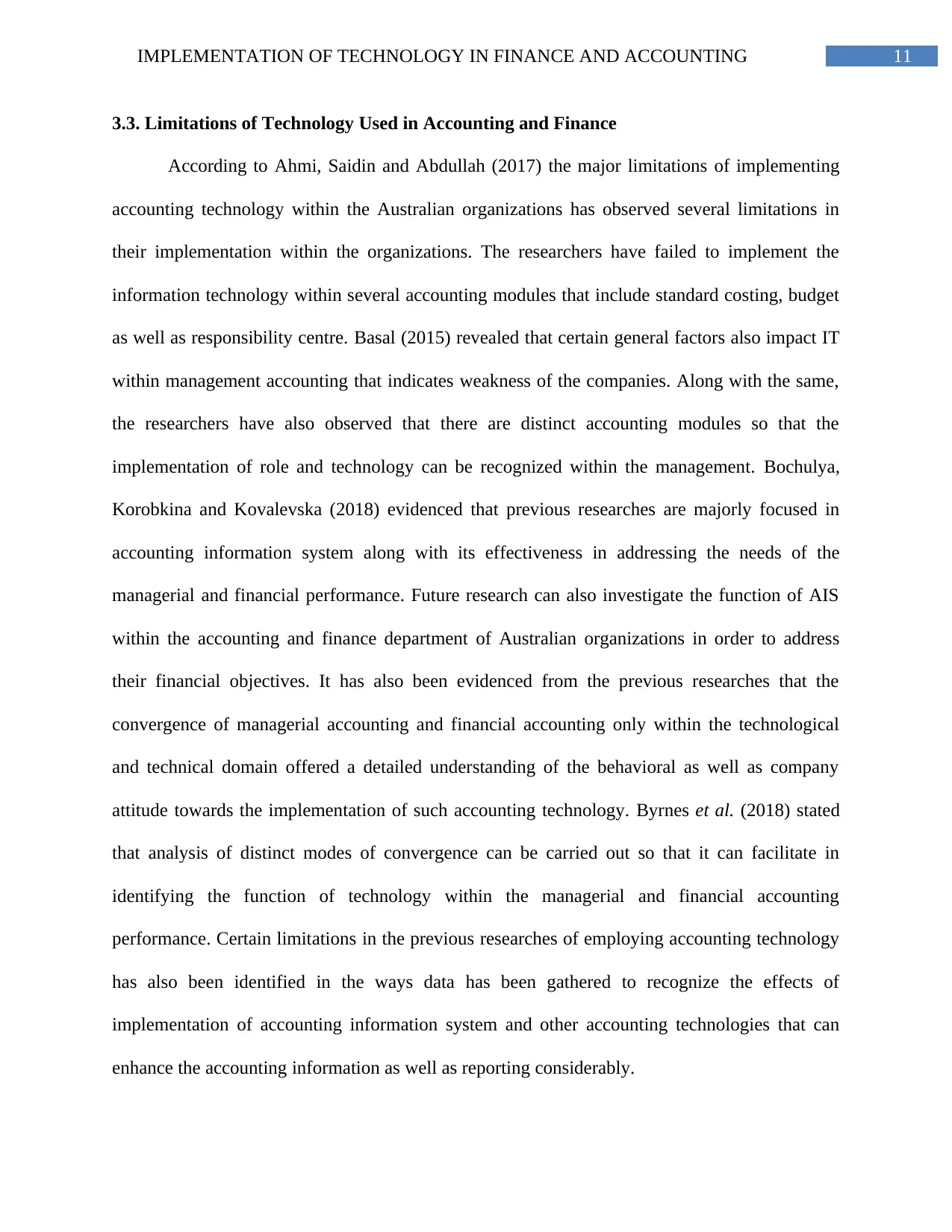
11IMPLEMENTATION OF TECHNOLOGY IN FINANCE AND ACCOUNTING
3.3. Limitations of Technology Used in Accounting and Finance
According to Ahmi, Saidin and Abdullah (2017) the major limitations of implementing
accounting technology within the Australian organizations has observed several limitations in
their implementation within the organizations. The researchers have failed to implement the
information technology within several accounting modules that include standard costing, budget
as well as responsibility centre. Basal (2015) revealed that certain general factors also impact IT
within management accounting that indicates weakness of the companies. Along with the same,
the researchers have also observed that there are distinct accounting modules so that the
implementation of role and technology can be recognized within the management. Bochulya,
Korobkina and Kovalevska (2018) evidenced that previous researches are majorly focused in
accounting information system along with its effectiveness in addressing the needs of the
managerial and financial performance. Future research can also investigate the function of AIS
within the accounting and finance department of Australian organizations in order to address
their financial objectives. It has also been evidenced from the previous researches that the
convergence of managerial accounting and financial accounting only within the technological
and technical domain offered a detailed understanding of the behavioral as well as company
attitude towards the implementation of such accounting technology. Byrnes et al. (2018) stated
that analysis of distinct modes of convergence can be carried out so that it can facilitate in
identifying the function of technology within the managerial and financial accounting
performance. Certain limitations in the previous researches of employing accounting technology
has also been identified in the ways data has been gathered to recognize the effects of
implementation of accounting information system and other accounting technologies that can
enhance the accounting information as well as reporting considerably.
3.3. Limitations of Technology Used in Accounting and Finance
According to Ahmi, Saidin and Abdullah (2017) the major limitations of implementing
accounting technology within the Australian organizations has observed several limitations in
their implementation within the organizations. The researchers have failed to implement the
information technology within several accounting modules that include standard costing, budget
as well as responsibility centre. Basal (2015) revealed that certain general factors also impact IT
within management accounting that indicates weakness of the companies. Along with the same,
the researchers have also observed that there are distinct accounting modules so that the
implementation of role and technology can be recognized within the management. Bochulya,
Korobkina and Kovalevska (2018) evidenced that previous researches are majorly focused in
accounting information system along with its effectiveness in addressing the needs of the
managerial and financial performance. Future research can also investigate the function of AIS
within the accounting and finance department of Australian organizations in order to address
their financial objectives. It has also been evidenced from the previous researches that the
convergence of managerial accounting and financial accounting only within the technological
and technical domain offered a detailed understanding of the behavioral as well as company
attitude towards the implementation of such accounting technology. Byrnes et al. (2018) stated
that analysis of distinct modes of convergence can be carried out so that it can facilitate in
identifying the function of technology within the managerial and financial accounting
performance. Certain limitations in the previous researches of employing accounting technology
has also been identified in the ways data has been gathered to recognize the effects of
implementation of accounting information system and other accounting technologies that can
enhance the accounting information as well as reporting considerably.
⊘ This is a preview!⊘
Do you want full access?
Subscribe today to unlock all pages.

Trusted by 1+ million students worldwide
1 out of 26
Related Documents
Your All-in-One AI-Powered Toolkit for Academic Success.
+13062052269
info@desklib.com
Available 24*7 on WhatsApp / Email
![[object Object]](/_next/static/media/star-bottom.7253800d.svg)
Unlock your academic potential
Copyright © 2020–2025 A2Z Services. All Rights Reserved. Developed and managed by ZUCOL.





